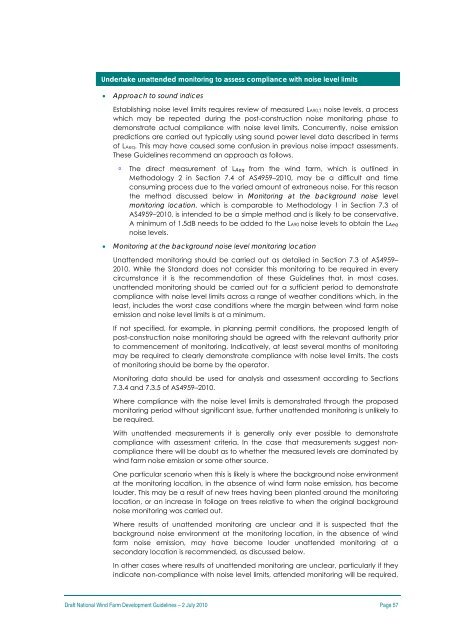Draft National Wind Farm Development Guidelines - July 2010
Draft National Wind Farm Development Guidelines - July 2010
Draft National Wind Farm Development Guidelines - July 2010
You also want an ePaper? Increase the reach of your titles
YUMPU automatically turns print PDFs into web optimized ePapers that Google loves.
Undertake unattended monitoring to assess compliance with noise level limits<br />
• Approach to sound indices<br />
Establishing noise level limits requires review of measured LA90,T noise levels, a process<br />
which may be repeated during the post-construction noise monitoring phase to<br />
demonstrate actual compliance with noise level limits. Concurrently, noise emission<br />
predictions are carried out typically using sound power level data described in terms<br />
of LAeq. This may have caused some confusion in previous noise impact assessments.<br />
These <strong>Guidelines</strong> recommend an approach as follows.<br />
<br />
The direct measurement of LAeq from the wind farm, which is outlined in<br />
Methodology 2 in Section 7.4 of AS4959–<strong>2010</strong>, may be a difficult and time<br />
consuming process due to the varied amount of extraneous noise. For this reason<br />
the method discussed below in Monitoring at the background noise level<br />
monitoring location, which is comparable to Methodology 1 in Section 7.3 of<br />
AS4959–<strong>2010</strong>, is intended to be a simple method and is likely to be conservative.<br />
A minimum of 1.5dB needs to be added to the LA90 noise levels to obtain the LAeq<br />
noise levels.<br />
• Monitoring at the background noise level monitoring location<br />
Unattended monitoring should be carried out as detailed in Section 7.3 of AS4959–<br />
<strong>2010</strong>. While the Standard does not consider this monitoring to be required in every<br />
circumstance it is the recommendation of these <strong>Guidelines</strong> that, in most cases,<br />
unattended monitoring should be carried out for a sufficient period to demonstrate<br />
compliance with noise level limits across a range of weather conditions which, in the<br />
least, includes the worst case conditions where the margin between wind farm noise<br />
emission and noise level limits is at a minimum.<br />
If not specified, for example, in planning permit conditions, the proposed length of<br />
post-construction noise monitoring should be agreed with the relevant authority prior<br />
to commencement of monitoring. Indicatively, at least several months of monitoring<br />
may be required to clearly demonstrate compliance with noise level limits. The costs<br />
of monitoring should be borne by the operator.<br />
Monitoring data should be used for analysis and assessment according to Sections<br />
7.3.4 and 7.3.5 of AS4959–<strong>2010</strong>.<br />
Where compliance with the noise level limits is demonstrated through the proposed<br />
monitoring period without significant issue, further unattended monitoring is unlikely to<br />
be required.<br />
With unattended measurements it is generally only ever possible to demonstrate<br />
compliance with assessment criteria. In the case that measurements suggest noncompliance<br />
there will be doubt as to whether the measured levels are dominated by<br />
wind farm noise emission or some other source.<br />
One particular scenario when this is likely is where the background noise environment<br />
at the monitoring location, in the absence of wind farm noise emission, has become<br />
louder. This may be a result of new trees having been planted around the monitoring<br />
location, or an increase in foliage on trees relative to when the original background<br />
noise monitoring was carried out.<br />
Where results of unattended monitoring are unclear and it is suspected that the<br />
background noise environment at the monitoring location, in the absence of wind<br />
farm noise emission, may have become louder unattended monitoring at a<br />
secondary location is recommended, as discussed below.<br />
In other cases where results of unattended monitoring are unclear, particularly if they<br />
indicate non-compliance with noise level limits, attended monitoring will be required,<br />
<strong>Draft</strong> <strong>National</strong> <strong>Wind</strong> <strong>Farm</strong> <strong>Development</strong> <strong>Guidelines</strong> – 2 <strong>July</strong> <strong>2010</strong> Page 57
















